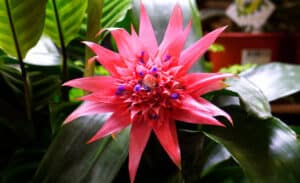What is a Silver Vase plant?
Silver vase plant, also known as urn plant is a species of the flowering plant in the bromeliad family. It is a houseplant and is native to Brazil. Silver vase plant is the best species in this genus that become successful in gaining the Royal Horticultural Society’s Award of Garden Merit. This eye-catchy plant is also known as Aechmea fasciata and has elliptic-oval shaped leaves.
The silver vase plant grows slowly, reaches 30 cm to 90 cm in height with a spread of up to 60 cm with 45 cm to 90 cm thick, arching, long gray-green leaves, and arranged in a basal rosette pattern. The unique leaves make the plant form an upturned waxy cup in the center, which collects the water and nutrients that the plant requires. The real flowers are small blue blooms that grow between the pink bracts which last for 5 or 6 months, although the blue flowers die quickly.

How to grow a Silver vase plant?
Fasciata is exceptionally easy to care for, look amazing, and can be grown in many locations throughout your home and requires partial shade and well-drained, moisture-retentive soil.
- To grow silver vase plant, first, all you need is well-drained, moisture-retentive soil, orchid potting soil with good drainage; otherwise, roots rot problem might appear.
- Use equal parts of peat moss, coarse sand, and leaf mold to make the potting mix yourself. Also add equal parts of fir bark, and sharp sand or perlite.
- While growing any plant, selecting the pot is a significant task. You can grow your plant in a 4 inch or 6-inch pot when it is young. After 3 to 4 years the plant reaches its maturity, and you need to move the plant to an 8-inch pot. Do not rush to repot the plant as they love to be root-bound in small containers.
- Likewise, while selecting the plant, do not select the one, which has already small blue flowers as they might soon fade.
- Likewise, it requires bright light to flower, so once the pink bracts appear, move the plant to lower light to elongate the colorful bracts.
- Water the plant regularly. The plant requires freshwater. So clean the cup once a week and replace the water with clean water. It prevents diseases, gnats, mosquitos and fungal plant diseases such as root rot, crown rot, rust diseases, and leaf spot.
- After that, moisten the soil and do not water again until the top of the soil has dried out but never allow the soil to dry out completely.
- Never use hard water instead use distilled water because the lime in hard water disfigures the leaves. Since these plants have a tiny, root system, so be careful not to overwater.
How to care Silver vase plant?
- The required temperature for this plant is between 60 degrees Fahrenheit to 75 degrees Fahrenheit (17 degrees Celsius to 24 degrees Celsius). It can survive colder temperatures than that of other species of this genus and requires moderate humidity.
- It produces a tall flower stalk with numerous pink bracts after three or four years when the plant becomes mature.
- Fertilize your plant monthly in the spring, summer, and fall with a liquid fertilizer. During the winter, fertilize it every other month. The best way you can apply is spraying the liquid fertilizer directly on the leaves.
- This plant can be propagated using the pups or offsets that grow around the base of the plant. When the pups or offsets are about 6 inches (15cm) in size, you can propagate them by digging them up and planting them in a 4-inch pot of their own.
- Sometimes, your plant also might face several common problems due to specific reasons. No blooming, brown/scorched leaf tips, bad/rotten smell, dry/brown patches, and disfigured leaves are few of them. The pink spiky flowers sometimes do not bloom due to overwatering or lack of fertilizing. Therefore, you need to fill the cup regularly.
- Likewise, the bad or rotten smell might come from the plant that is because of stagnant water inside the cup. You need to remove the water every two to three months.
- The direct sunlight or low humidity might cause the dry or patched leaves. To overcome this problem, move the plant to any room with bright but indirect light and water it properly. You may add moisture if necessary.
- Disfigured leaves may occur if you use hard water on the plant.

